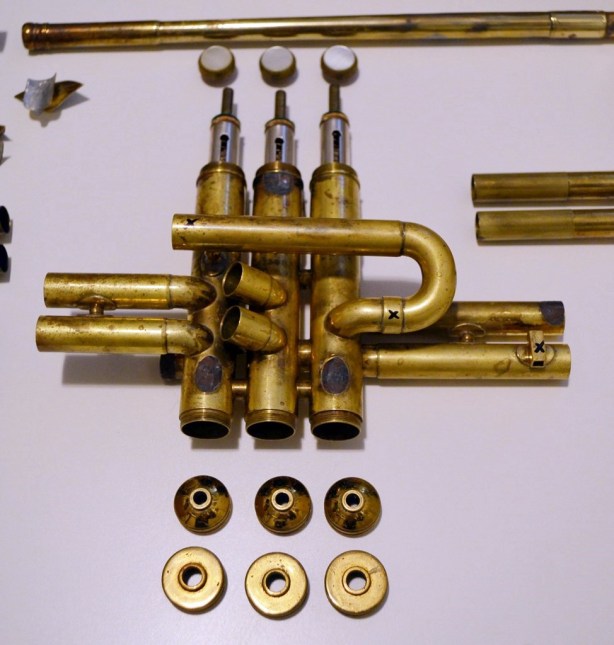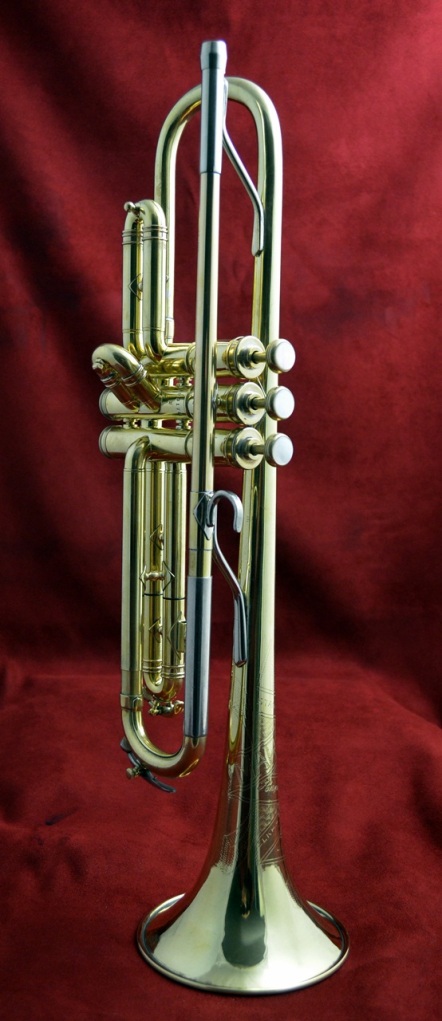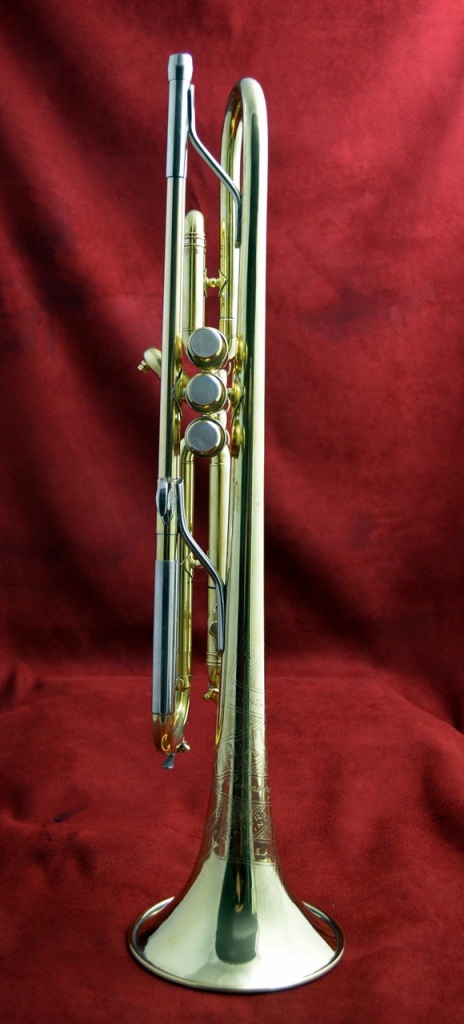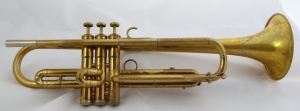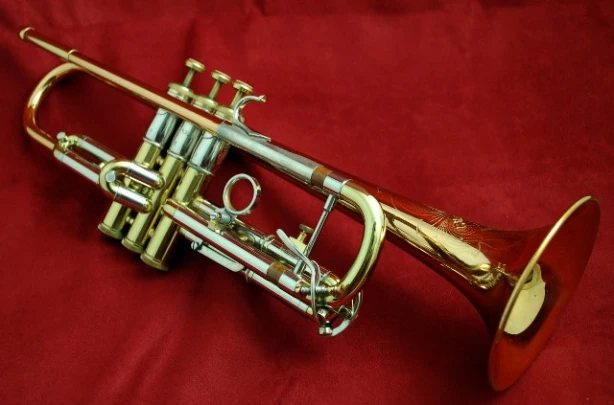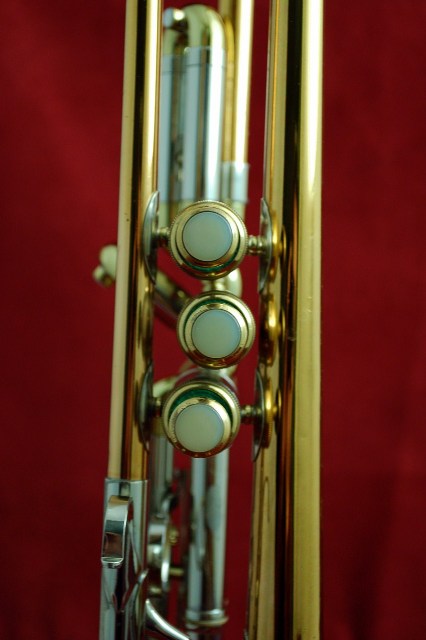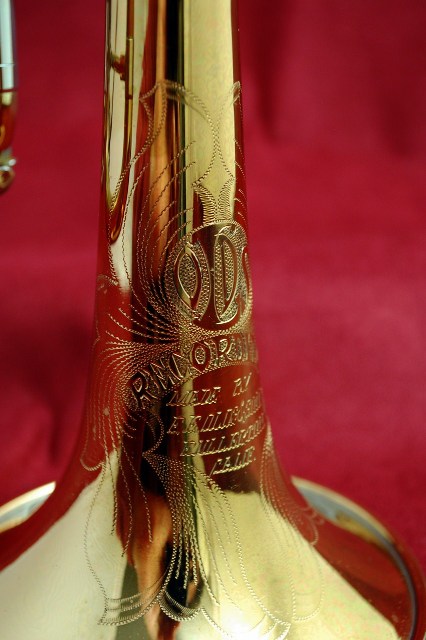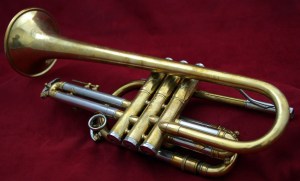Part 2 of 2
Apologies for the really delayed post, but here’s the completed horn in all it’s glory.
(Sorry about the logo there – but I notice a lot of people using my images for reference and tagging – so they need to know where they can find all these great horns)
It’s amazing how a collection of parts can be assembled into something completely different by someone who knows what they are doing. Josh is the Master!

Interestingly – the lead pipe I sent with the horn was able to be saved – so that saved a good chunk of change from now having to pay for a newly hand drawn pipe.
Everything else that I sent was incorporated into the build.
You can see where the main tuning slide steps into the valve block that there is a smaller tube there – that design is actually the same as some of the early Benge trumpets.
Using a Cornet valve block was a great idea – lower cost and almost exactly the same as the trumpet block. I already have another block and pistons for another project lined up. I added the rubber bumpers on the 1st and 2nd valve slides as the slides were just 1mm or less larger than the tubes. (I attribute that to using 1930’s slides with a 1950’s valve block) With the bumpers there it all sits flush. I guess this could have been trimmed – but that would risk throwing off the intonation.
The only negative is the 3rd valve slide – the slides fits so well and the horn holds quite the amount of pressure that it impacts the operation of the 3rd valve slide a bit.
Sound: That’s the best part of this horn – it has come away with a dark, and full sound profile to it – it’s very much in the style of the large bore Martins, and also the 3/9 Calicchio. Needless to say that I was very happy with the outcome. (I’ve already had offers from players to buy this horn). You could pay twice as much and still not get as good of a horn as this one. It’s got a bit of resistance in there – but a big full sound to it.
Bits I would change if I were to do it again:
– Leadpipe – as much as I really like this one. I wonder how much more fluid the horn would have been with the Committee style pipe.
– Main Braces – I really like the older Martin Handcraft Committee braces (which I think was borrowed from the French Besson design). Essentially a post in the middle with two connectors soldered. This I think allowed for less tension in the build. I personally also think that contributes a little to why the earlier horns have slightly better higher overtones in the sound than the later models.
Bits I really like:
– Call me weird, but I really like the Indiana Finger Button design – they were built round and solid like a button with two grooves cut into it all the way around. Simple, good weight and feels good. These are much better than the earlier Handcraft designs which were quite small.
– The #3 Bell. Wow! – I get it. These are good, really good. Now if you wanted to buy one new (if you can) they were about the US$900+ mark. I’ve been looking but these are very hard to come by. In fact, hand made bells by many makers are quite hard to come by for that matter.
– Valve block. Yep it looks and feels the same, and pretty much there is zero draw backs (unless you have an issue with the connecting piece)
– Older valve slides and parts: These look much nicer in my opinion than the later models. There are more grooves, more weight and a higher quality brass used. If you look at the main tuning slide you can see it’s braced from the back of the crook. All these little touches were lost in later designs so they could pump out more horns and make higher profits. If you want a lesson in real craftsmanship look at some of the 1900’s – 1930’s horns that were built.
Cost:
I’d love to share with you all how much this build cost, but I can’t – as I get pretty good deals on the building process. I will venture to say that it’s a lot less than a new horn. So before you go out and put your hard earned cash down on a new horn – why not recycle something old and turn it into something unique? There are many great custom builders worldwide who can do just that. It’s also quite the adventure tracking down parts and elements you might like to incorporate.
I will give you a rough breakdown on parts alone:
Bell = $350.00
Tuning Slide and Slides & Leadpipe = Approx $150(Got them off a Martin Handcraft Standard Bb Trumpet donor horn I paid $350 for. Sold the bell and valves to pay for the rest)
Valve Block and Pistons = $150 (This is a good price – expect to pay more)
Trim (Buttons, Caps & Tops) = $105 (Committee style caps will sell for up to $50 per cap – so see if you can find the older Handcraft Imperial/Standard or Indiana ones – they are close to half that).
All in all, well worth the trouble! Good luck with your own projects.


